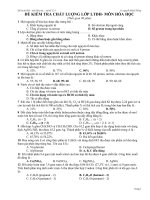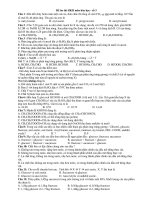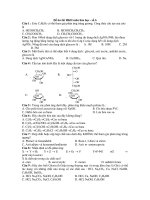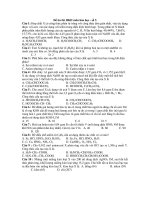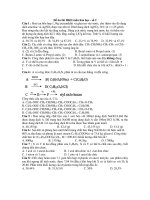Đề ôn thi thử môn hóa (815)
Bạn đang xem bản rút gọn của tài liệu. Xem và tải ngay bản đầy đủ của tài liệu tại đây (216.59 KB, 5 trang )
1080 S E C T I O N I X Pediatric Critical Care: Hematology and Oncology
TABLE
90.4 Assays Used in the Monitoring of UFH Therapy
Assay
Common Uses
Advantages
Disadvantages in Children
aPTT
F-Clot
Coagulation screening assay
Therapeutic UFH monitoring
Low cost
Easy to perform
Widely available
Baseline aPTT often prolonged in children
Wide variability in reagent sensitivity to age-related differences
Nonphysiologic measure of UFH effect
No validation of therapeutic ranges in children
TCT
F-Clot
Coagulation screening assay
Therapeutic UFH monitoring
(rarely)
Easy to perform
Patients previously exposed to topical thrombin may have antibodies
causing prolongation of the clotting time
Optimal concentration of thrombin used for the assay is unknown
No validated reference range for UFH in children
ACT
F-Clot
CPB, extracorporeal circuits
Easy bedside whole blood test
Extensive experience in most PICUs
Does not correlate with any specific measures of heparin activity
Analyzer dependent
Anti-Xa
F-Ch
Calibration of aPTT
reference ranges
Therapeutic UFH monitoring
Direct measure of UFH inhibition
of Xa
Easy to perform
Not as widely available as aPTT and costs significantly more
Does not measure other mechanisms of UFH effect (e.g., anti-IIa) and
assumes constant ration of effect, which is not true in children
Some kits have exogenous AT, others have dextran sulphate, both of
which will introduce in vitro error in small children for different
reasons
Protamine
titration Q
Not used clinically
Used by reference
laboratories
Only assay that directly measures
UFH concentration
Low cost
Not widely available
Automated methods have not been validated for management of
therapeutic UFH and manual methods labor intensive
aPTT, Activated partial thromboplastin time; AT, antithrombin; CPB, cardiopulmonary bypass; F-Ch, functional, chromogenic assay; F-Clot, functional, clot-based assay; PICUs, pediatric intensive care
units; Q, quantitative assay; TCT, thrombin clotting time; UFH, unfractionated heparin.
It is not hard to see how such errors occur in busy units that operate 24 hours per day. Units should actively manage the choices of
UFH preparations available to their staff to minimize the risk of
confusion. Staff should be educated in the dangers of UFH and
encouraged to be vigilant at all times when administering a drug
that consistently ranks in hospital lists of the drugs most commonly involved in medication errors.
Another adverse event from UFH only recently reported has
been anaphylaxis, which in 2007 to 2008 accounted for over 80
deaths due to an unintended contaminant introduced in the manufacturing process.118 Again, while there is almost nothing in the
medical literature describing these events, the FDA released a number of warning statements; one impact of this has been changes to
the labeling of UFH. The potential for contamination of drug products made from biological sources will always be real. An important
mechanism to minimize this risk is to ensure that children receive
UFH only when the risks are clearly outweighed by the benefits.
UFH has been described as being ubiquitous in PICUs; thus, clinicians should actively minimize unnecessary exposure to it.
In summary, anticoagulation in children in the PICU is common, and UFH is currently the most common anticoagulant.
While there remain many concerns about the potential adverse
effects of UFH, there are currently no real alternative anticoagulant agents available for intravenous use in sick children. Many
adverse events are related to dosing errors, and it is likely that
PICUs can significantly improve the safety of UFH by developing
systems to prevent medication errors. In addition, there is emerging evidence that our understanding of the pharmacokinetics of
UFH in children and of the assays used to monitor UFH in children is far from ideal. Urgent research is required to improve the
safety and utility of UFH in critically ill children.
Thromboprophylaxis in the Pediatric Intensive
Care Unit
In critically ill adults, pharmacologic thromboprophylaxis is
highly recommended owing to its proven efficacy and safety in
the prevention of DVT. The patient populations that require
pharmacologic prophylaxis in pediatrics are less well defined.119
One of the many issues with studying this area is the difference
in nomenclature regarding “prophylaxis.” VTE prophylaxis
with UFH or LMWH is often confused with “line prophylaxis”
or “line patency prophylaxis” (usually UFH but at very different doses). The increasing incidence of thromboembolism in
the PICU patient has led several institutions to develop risk
stratification protocols to target patients at the highest risk.120,121
The most common risk factors remain the presence of CVAD,
cardiac disease, and infants younger than 1 year.122 There is a
variety of practice depending on the center; currently, between
0% and 50% of children receive thromboprophylaxis.123–127 A
prospective study examining pediatric trauma patients developed a risk stratification protocol and found a decrease by 65%
in VTE with implementation of this protocol. Of note in this
study of 76 patients determined to be high risk for VTE, only
two received pharmacologic thromboprophylaxis as per their
protocol.128
Generalized routine thromboprophylaxis is unlikely to be of
benefit in the PICU. The development of risk assessment tools
and their effectiveness remains an area of ongoing research.
Nonpharmacologic thromboprophylaxis should be encouraged.
Minimization of concurrent risk factors, early mobilization,
and removal of CVADs as soon as feasible seem to be sensible
strategies.
1080.e1
• eFig.
90.3 Preparations of unfractionated heparin (UFH) commonly
found on an Australian pediatric ward. Note the minimal differences in
packaging and the significant differences in UFH concentration, such that
there is potential for a 100-fold overdose should a selection error be
made.
CHAPTER 90 Thrombosis in Pediatric Critical Care
Conclusions
Thromboembolic disease is now a major cause of mortality and
morbidity in critically ill children in the context of children having marked differences in the hemostatic system compared with
adults, which appear to be age related. There remains much to be
learned about the etiology and clinical presentations of thrombosis. Diagnostic strategies are mostly extrapolated from adult studies but are likely suboptimal. Similarly, management strategies
and the use of anticoagulants in children for either treatment or
primary prophylaxis are guided by minimal evidence; thus, there
is a desperate need for further research. In the meantime, clinical
decisions must be made. For the time being, these decisions require consideration of the individual risk-benefit ratios for each
patient.
Key References
Andrew M, Vegh P, Johnston M, Bowker J, Ofosu F, Mitchell L. Maturation of the hemostatic system during childhood. Blood. 1992;80(8):
1998-2005.
Arlikar SJ, Atchison CM, Amankwah EK, et al. Development of a new
risk score for hospital-associated venous thromboembolism in critically-ill children not undergoing cardiothoracic surgery. Thromb Res.
2015;136(4):717-722.
Attard C, Huang J, Monagle P, Ignjatovic V. Pathophysiology of thrombosis and anticoagulation post Fontan surgery. Thromb Res.
2018;172:204-213.
Attard C, Huang J, Monagle P, Ignjatovic V. Pathophysiology of thrombosis and
anticoagulation post Fontan surgery. Thromb Res. 2018;172:204-213.
Barton R, Ignjatovic V, Monagle P. Anticoagulation during ECMO in
neonatal and paediatric patients. Thromb Res. 2019;173:172-177.
Chalmers EA. Epidemiology of venous thromboembolism in neonates
and children. Thromb Res. 2006;118(1):3-12.
Fan H, Zhu JH. A multifaceted anticoagulation strategy is needed for
children supported with ECMO. J Intensive Care Med. 2018;
33(2):142.
Hanson S, Punzalan R, Arca M. Effectiveness of clinical guidelines for
deep vein thrombosis prophylaxis in reducing the incidence of venous
thromboembolism in critically ill children after trauma. J Trauma.
2014;72(5):1292-1297.
Hanson SJ, Faustino EV, Mahajerin A, et al. Recommendations for venous thromboembolism prophylaxis in pediatric trauma patients: A
national, multidisciplinary consensus study. J Trauma Acute Care
Surg. 2016;80(5):695-701.
Hanson SJ, Lawson KA, Brown AM, et al. Current treatment practices
of venous thromboembolism in children admitted to pediatric intensive care units. Paediatr Anaesth. 2011;21(10):1052-1057.
1081
Higgerson RA, Lawson KA, Christie LM, et al. Incidence and risk factors
associated with venous thrombotic events in pediatric intensive care
unit patients. Pediatr Crit Care Med. 2011;12(6):628-634.
Huang JY, Ignjatovic V, Sheridan BJ, et al. Bleeding and thrombotic
events occur early in children on durable ventricular assist devices.
Thromb Res. 2019;173:65-70.
Huang JY, Monagle P, Massicotte MP, VanderPluym CJ. Antithrombotic
therapies in children on durable Ventricular Assist Devices: a literature review. Thromb Res. 2018;172:194-203.
Jones S, Butt W, Monagle P, Cain T, Newall F. The natural history of
asymptomatic central venous catheter-related thrombosis in critically
ill children. Blood. 2019;133(8):857-866.
Male C, Chait P, Ginsberg JS, et al. Comparison of venography and ultrasound for the diagnosis of asymptomatic deep vein thrombosis in
the upper body in children: results of the PARKAA study. Prophylactic antithrombin replacement in kids with ALL treated with asparaginase, Thromb Haemost. 2002;87(4):593-598.
Manlhiot C, Brandão LR, Schwartz SM, et al. Management and outcomes of patients with occlusive thrombosis after pediatric cardiac
surgery. J Pediatr. 2016;169:146-153.
Monagle P, Chan AK, Goldenberg NA, et al. Antithrombotic therapy in
neonates and children: Antithrombotic Therapy and Prevention of
Thrombosis, 9th ed: American College of Chest Physicians EvidenceBased Clinical Practice Guidelines. Chest. 2012;141(suppl 2):e737Se801S.
Monagle P, Cochrane A, Roberts R, et al. A multicenter, randomized trial
comparing heparin/warfarin and acetylsalicylic acid as primary
thromboprophylaxis for 2 years after the Fontan procedure in children. J Am Coll Cardiol. 2011;58(6):645-651.
Monagle P, Cuello CA, Augustine C, et al. American Society of Hematology 2018 Guidelines for management of venous thromboembolism:
treatment of pediatric venous thromboembolism. Blood Adv.
2018;2(22):3292-3316.
Raffini L. Anticoagulation with VADs and ECMO: walking the tightrope. Hematology Am Soc Hematol Educ Program. 2017;2017(1):
674-680.
Rizzi M, Albisetti M. Treatment of arterial thrombosis in children: methods and mechanisms. Thromb Res. 2018;169:113-119.
Rizzi M, Goldenberg N, Bonduel M, Revel-Vilk S, Amankwah E,
Albisetti M. Catheter-related arterial thrombosis in neonates
and children: a systematic review. Thromb Haemost. 2018;118(6):
1058-1066.
Vidal E, Sharathkumar A, Glover J, Faustino EV. Central venous catheterrelated thrombosis and thromboprophylaxis in children: a systematic
review and meta-analysis. J Thromb Haemost. 2014 ;12(7):1096-1109.
Wessel DL, Berger F, Li JS, et al. Clopidogrel in infants with systemic-topulmonary-artery shunts. N Engl J Med. 2013;368(25):2377-2384.
The full reference list for this chapter is available at ExpertConsult.com.
e1
References
1. Andrew M, Paes B, Milner R, et al. Development of the human
coagulation system in the full-term infant. Blood. 1987;70(1):
165-172.
2. Andrew M, Paes B, Milner R, et al. Development of the human
coagulation system in the healthy premature infant. Blood.
1988;72(5):1651-1657.
3. Andrew M, Paes B, Johnston M. Development of the hemostatic
system in the neonate and young infant. Am J Pediatr Hematol
Oncol. 1990;12(1):95-104.
4. Andrew M, Vegh P, Johnston M, Bowker J, Ofosu F, Mitchell L.
Maturation of the hemostatic system during childhood. Blood.
1992;80(8):1998-2005.
5. Reverdiau-Moalic P, Delahousse B, Body G, Bardos P, Leroy J, Gruel
Y. Evolution of blood coagulation activators and inhibitors in the
healthy human fetus. Blood. 1996;88(3):900-906.
6. Ignjatovic V, Pelkmans L, Kelchtermans H, et al. Differences in the
mechanism of blood clot formation and nanostructure in infants and
children compared with adults. Thromb Res. 2015;136(6):1303-1309.
7. Karlaftis V, Perera S, Monagle P, Ignjatovic V. Importance of posttranslational modifications on the function of key haemostatic proteins. Blood Coagul Fibrinolysis. 2016;27(1):1-4.
8. Ignjatovic V, Lai C, Summerhayes R, et al. Age-related differences in
plasma proteins: how plasma proteins change from neonates to
adults. PLoS One. 2011;6(2):e17213.
9. Yip C, Ignjatovic V, Attard C, Monagle P, Linden MD. First report
of elevated monocyte-platelet aggregates in healthy children. PLoS
One. 2013;8(6):e67416.
10. Cini C, Yip C, Attard C, et al. Differences in the resting platelet
proteome and platelet releasate between healthy children and adults.
J Proteomics. 2015;123:78-88.
11. Andrew M, Mitchell L, Vegh P, Ofosu F. Thrombin regulation in
children differs from adults in the absence and presence of heparin.
Thromb Haemost. 1994;72(6):836-842.
12. Chan AK, Berry LR, Monagle PT, Andrew M. Decreased concentrations of heparinoids are required to inhibit thrombin generation in
plasma from newborns and children compared to plasma from
adults due to reduced thrombin potential. Thromb Haemost.
2002;87(4):606-613.
13. Massicotte P, Leaker M, Marzinotto V, et al. Enhanced thrombin
regulation during warfarin therapy in children compared to adults.
Thromb Haemost. 1998;80(4):570-574.
14. Moalic P, Gruel Y, Body G, Foloppe P, Delahousse B, Leroy J. Levels
and plasma distribution of free and C4b-BP-bound protein S in human
fetuses and full-term newborns. Thromb Res. 1988;49(5):471-480.
15. Schwarz HP, Muntean W, Watzke H, Richter B, Griffin JH. Low
total protein S antigen but high protein S activity due to decreased
C4b-binding protein in neonates. Blood. 1988;71(3):562-565.
16. Ignjatovic V, Greenway A, Summerhayes R, Monagle P. Thrombin
generation: the functional role of alpha-2-macroglobulin and influence of developmental haemostasis. Br J Haematol. 2007;
138(3):366-368.
17. Nako Y, Ohki Y, Harigaya A, Tomomasa T, Morikawa A. Plasma
thrombomodulin level in very low birthweight infants at birth. Acta
Paediatr. 1997;86(10):1105-1109.
18. Van Dreden P, et al. Tissue factor pathway inhibitor in infants and
children. Thromb Haemost Suppl. 2001;P2314.
19. Monagle P, Cuello CA, Augustine C, et al. American Society of
Hematology 2018 Guidelines for management of venous thromboembolism: treatment of pediatric venous thromboembolism. Blood
Adv. 2018;2(22):3292-3316.
20. Attard C, Huang J, Monagle P, Ignjatovic V. Pathophysiology of
thrombosis and anticoagulation post Fontan surgery. Thromb Res.
2018;172:204-213.
21. Huang JY, Monagle P, Massicotte MP, VanderPluym CJ. Antithrombotic therapies in children on durable Ventricular Assist Devices: A
literature review. Thromb Res. 2018;172:194-203.
22. Huang JY, Ignjatovic V, Sheridan BJ, et al. Bleeding and thrombotic
events occur early in children on durable ventricular assist devices.
Thromb Res. 2019;173:65-70.
23. Barton R, Ignjatovic V, Monagle P. Anticoagulation during ECMO in
neonatal and paediatric patients. Thromb Res. 2019;173:172-177.
24. MacLaren G, Monagle P. Antithrombin administration in extracorporeal membrane oxygenation patients: putting the cart before the
horse. Pediatr Crit Care Med. 2016;17(12):1188-1189.
25. Fan H, Zhu JH. A Multifaceted anticoagulation strategy is needed
for children supported with ECMO. J Intensive Care Med. 2018;
33(2):142.
26. Raffini L. Anticoagulation with VADs and ECMO: walking the
tightrope. Hematology Am Soc Hematol Educ Program. 2017;2017(1):
674-680.
27. Koster A, Ljajikj E, Faraoni D. Traditional and non-traditional anticoagulation management during extracorporeal membrane oxygenation. Ann Cardiothorac Surg. 2019;8(1):129-136.
28. Chalmers EA. Epidemiology of venous thromboembolism in neonates and children. Thromb Res. 2006;118(1):3-12.
29. Faustino EV, Shabanova V, Pinto MG, et al. Epidemiology of lower
extremity deep venous thrombosis in critically ill adolescents. J Pediatr.
2018;201:176-183.
30. Higgerson RA, Lawson KA, Christie LM, et al. Incidence and risk
factors associated with venous thrombotic events in pediatric intensive care unit patients. Pediatr Crit Care Med. 2011;12(6):628-634.
31. Faustino EV. Central venous catheter-associated deep venous thrombosis in critically ill children. Semin Thromb Hemost. 2018;44(1):52-56.
32. Faustino EV, Raffini LJ. Prevention of hospital-acquired venous
thromboembolism in children: a review of published guidelines.
Front Pediatr. 2017;5:9.
33. Mannarino CN, Faustino EV. Clinical equipoise on prophylaxis
against catheter-associated thrombosis in critically ill children. J Crit
Care. 2016;32:26-30.
34. Vidal E, Sharathkumar A, Glover J, Faustino EV. Central venous
catheter-related thrombosis and thromboprophylaxis in children: a
systematic review and meta-analysis. J Thromb Haemost.
2014;12(7):1096-1109.
35. Jones S, Butt W, Monagle P, Cain T, Newall F. The natural history
of asymptomatic central venous catheter-related thrombosis in critically ill children. Blood. 2019;133(8):857-866.
36. O’Brien S. A silent response to silent thrombosis. Blood. 2019;
133(8):776-777.
37. Rizzi M, Goldenberg N, Bonduel M, Revel-Vilk S, Amankwah E,
Albisetti M. Catheter-related arterial thrombosis in neonates and
children: a systematic review. Thromb Haemost. 2018;118(6):10581066.
38. Rizzi M, Albisetti M. Treatment of arterial thrombosis in children:
Methods and mechanisms. Thromb Res. 2018;169:113-119.
39. Rizzi M, Kroiss S, Kretschmar O, Forster I, Brotschi B, Albisetti M.
Long-term outcome of catheter-related arterial thrombosis in infants
with congenital heart disease. J Pediatr. 2016;170:181-187.
40. Brotschi B, Hug MI, Kretschmar O, Rizzi M, Albisetti M. Incidence
and predictors of cardiac catheterisation-related arterial thrombosis
in children. Heart. 2015;101(12):948-953.
41. Albisetti M, Rizzi M, Bonduel M, Revel-Vilk S, Goldenberg N;
Pediatric and Neonatal Thrombosis and Haemostasis Subcommittee
of the Scientific and Standardization Committee of the International
Society on Thrombosis and Haemostasis. Official communication of
the SSC: Recommendations for future research in catheter-related
arterial thrombosis in children. Res Pract Thromb Haemost.
2019;3(2):193-196.
42. Manlhiot C, Brandão LR, Schwartz SM, et al. Management and
outcomes of patients with occlusive thrombosis after pediatric cardiac surgery. J Pediatr. 2016;169:146-153.
43. Agarwal A, Firdouse M, Brar N, et al. Incidence and management
of thrombotic and thromboembolic complications following the
Norwood procedure: a systematic review. Clin Appl Thromb Hemost.
2017;23(8):911-921.
e2
44. Monagle P. Thrombosis in pediatric cardiac patients. Semin Thromb
Hemost. 2003;29(6):547-555.
45. Chittithavorn V, Duangpakdee P, Rergkliang C, Pruekprasert N.
Risk factors for in-hospital shunt thrombosis and mortality in patients weighing less than 3 kg with functionally univentricular heart
undergoing a modified Blalock-Taussig shunt. Interact Cardiovasc
Thorac Surg. 2017;25(3):407-413.
46. Vitanova K, Leopold C, von Ohain JP, et al. Reasons for failure of
systemic-to-pulmonary artery shunts in neonates. Thorac Cardiovasc
Surg. 2019;67(1):2-7.
47. Wessel DL, Berger F, Li JS, et al. Clopidogrel in infants with
systemic-to-pulmonary-artery shunts. N Engl J Med. 2013;368(25):
2377-2384.
48. Attard C, Huang J, Monagle P, Ignjatovic V. Pathophysiology of
thrombosis and anticoagulation post Fontan surgery. Thromb Res.
2018;172:204-213.
49. Monagle P, Cochrane A, McCrindle B, Benson L, Williams W, Andrew M. Thromboembolic complications after Fontan procedures–
the role of prophylactic anticoagulation. J Thorac Cardiovasc Surg.
1998;115(3):493-498.
50. Monagle P, Karl TR. Thromboembolic problems after the Fontan
operation. Semin Thorac Cardiovasc Surg Pediatr Card Surg Annu.
2002;5:36-47.
51. McCrindle BW, Manlhiot C, Cochrane A, et al. Factors associated
with thrombotic complications after the Fontan procedure: a secondary analysis of a multicenter, randomized trial of primary thromboprophylaxis for 2 years after the Fontan procedure. J Am Coll
Cardiol. 2013;61(3):346-353.
52. Pina LM, Dong X, Zhang L, et al. Rivaroxaban, a direct Factor Xa
inhibitor, versus acetylsalicylic acid as thromboprophylaxis in children
post-Fontan procedure: Rationale and design of a prospective, randomized trial (the UNIVERSE study). Am Heart J. 2019;213:97-104.
53. Payne RM, Burns KM, Glatz AC, et al. A multi-national trial of a
direct oral anticoagulant in children with cardiac disease: Design and
rationale of the Safety of ApiXaban On Pediatric Heart disease On
the preventioN of Embolism (SAXOPHONE) study. Am Heart J.
2019;217:52-63.
54. Monagle P, Cochrane A, Roberts R, et al. A multicenter, randomized
trial comparing heparin/warfarin and acetylsalicylic acid as primary
thromboprophylaxis for 2 years after the Fontan procedure in children. J Am Coll Cardiol. 2011;58(6):645-651.
55. Miletich JP, et al: Inherited predisposition to thrombosis. Cell
72(4):477–480, 1993.
56. Prins MH, Hirsh J. A critical review of the evidence supporting a
relationship between impaired fibrinolytic activity and venous
thromboembolism. Arch Intern Med. 1991;151(9):1721-1731.
57. Seligsohn U, Zivelin A. Thrombophilia as a multigenic disorder.
Thromb Haemost. 1997;78(1):297-301.
58. Nowak-Göttl U, van Ommen H, Kenet G. Thrombophilia testing
in children: What and when should be tested? Thromb Res.
2018;164:75-78.
59. Hedegaard SS, Klein AC, Hvas AM. The significance of thrombophilia in paediatric thromboembolism. Scand J Clin Lab Invest.
2018;78(7-8):551-555.
60. deVeber G, Kirkham F, Shannon K, et al. Recurrent stroke: the role
of thrombophilia in a large international pediatric stroke population.
Haematologica. 2019;104(8):1676-1681.
61. Bock ME, Bobrowski AE, Bhat R. Utility of thrombophilia screening in pediatric renal transplant recipients. Pediatr Transplant.
2019;23(1):e13314.
62. Young G, Albisetti M, Bonduel M, et al. Impact of inherited thrombophilia on venous thromboembolism in children: a systematic review and meta-analysis of observational studies. Circulation.
2008;118(13):1373-1382.
63. Neshat-Vahid S, Pierce R, Hersey D, Raffini LJ, Faustino EV. Association of thrombophilia and catheter-associated thrombosis in
children: a systematic review and meta-analysis. J Thromb Haemost.
2016;14(9):1749-1758.
64. Avila ML, Amiri N, Stanojevic S, et al. Can thrombophilia predict
recurrent catheter-related deep vein thrombosis in children? Blood.
2018;131(24):2712-2719.
65. Warkentin TE, Greinacher A, Koster A, Lincoff AM. Treatment
and prevention of heparin-induced thrombocytopenia. Chest. 2008;
133(suppl 6):340S-380S.
66. Klement D, Rammos S, v Kries R, Kirschke W, Kniemeyer HW,
Greinacher A. Heparin as a cause of thrombus progression. Heparinassociated thrombocytopenia is an important differential diagnosis
in paediatric patients even with normal platelet counts. Eur J Pediatr.
1996;155(1):11-14.
67. Magnani HN. Heparin-induced thrombocytopenia (HIT): an overview of 230 patients treated with orgaran (Org 10172). Thromb
Haemost. 1993;70(4):554-561.
68. Murdoch IA, Beattie RM, Silver DM. Heparin-induced thrombocytopenia in children. Acta Paediatr. 1993;82(5):495-497.
69. Potter C, Gill JC, Scott JP, McFarland JG. Heparin-induced thrombocytopenia in a child. J Pediatr. 1992;121(1):135-138.
70. Severin T, Sutor AH. Heparin-induced thrombocytopenia in pediatrics. Semin Thromb Hemost. 2001;27(3):293-299.
71. Boshkov L, et al. Heparin-induced thrombocytopenia (HIT) in
neonates and very young children undergoing congenital cardiac
surgery: a likely under-recognized complication with significant
morbidity and mortality: report of 4 sequential cases, J Thromb Haemost. 2003;1(suppl 1):1494a.
72. Etches W, Stang L, Conradi A. Incidence of Heparin-Induced
Thrombocytopenia in a pediatric intensive care population. Blood.
2003;102(Suppl):536a.
73. Klenner AF, Fusch C, Rakow A, et al. Benefit and risk of heparin for
maintaining peripheral venous catheters in neonates: a placebocontrolled trial. J Pediatr. 2003;143(6):741-745.
74. Newall F, Barnes C, Ignjatovic V, Monagle P. Heparin-induced
thrombocytopenia in children. J Paediatr Child Health. 2003;
39(4):289-292.
75. Schmugge M, Risch L, Huber AR, Benn A, Fischer JE. Heparininduced thrombocytopenia-associated thrombosis in pediatric intensive care patients. Pediatrics. 2002;109(1):E10.
76. Spadone D. Heparin induced thrombocytopenia in the newborn.
J Vasc Surg. 1996;15:306-312.
77. Lo GK, Sigouin CS, Warkentin TE. What is the potential for overdiagnosis of heparin-induced thrombocytopenia? Am J Hematol.
2007;82(12):1037-1043.
78. Klenner AF, Lubenow N, Raschke R, Greinacher A. Heparininduced thrombocytopenia in children: 12 new cases and review of
the literature. Thromb Haemost. 2004;91(4):719-724.
79. Risch L, Fischer JE, Herklotz R, Huber AR. Heparin-induced
thrombocytopenia in paediatrics: clinical characteristics, therapy and
outcomes. Intensive Care Med. 2004;30(8):1615-1624.
80. Saxon BR, Black MD, Edgell D, Noel D, Leaker MT. Pediatric
heparin-induced thrombocytopenia: management with Danaparoid
(orgaran). Ann Thorac Surg. 1999;68(3):1076-1078.
81. Severin T, Zieger B, Sutor AH. Anticoagulation with recombinant
hirudin and danaparoid sodium in pediatric patients. Semin Thromb
Hemost. 2002;28(5):447-454.
82. Chan VH, Monagle P, Massicotte P, Chan AK. Novel paediatric
anticoagulants: a review of the current literature. Blood Coagul Fibrinolysis. 2010;21(2):144-151.
83. Buck ML. Bivalirudin as an alternative to heparin for anticoagulation in
infants and children. J Pediatr Pharmacol Ther. 2015;20(6):408-417.
84. Obeng EA, Harney KM, Moniz T, Arnold A, Neufeld EJ, Trenor
CC III. Pediatric heparin-induced thrombocytopenia: prevalence,
thrombotic risk, and application of the 4Ts scoring system. J Pediatr.
2015;166(1):144-150.
85. Male C, Chait P, Ginsberg JS, et al. Comparison of venography and
ultrasound for the diagnosis of asymptomatic deep vein thrombosis
in the upper body in children: results of the PARKAA study. Prophylactic antithrombin replacement in kids with ALL treated with
asparaginase. Thromb Haemost. 2002;87(4):593-598.

